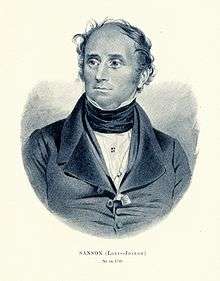Louis Joseph Sanson
Louis Joseph Sanson (24 January 1790, Paris – 2 August 1841, Paris) was a French surgeon and ophthalmologist.

In 1817 he obtained his medical doctorate, later becoming a surgeon to the "Bureau central" (1823). During the following year he was appointed "second surgeon" at the Hôtel-Dieu de Paris, and in 1830 received his agrégation (professeur agrégé). For a period of time he served as head of the ophthalmologic clinic at the Hôtel-Dieu. In 1836 he succeeded his former teacher and good friend, Guillaume Dupuytren (1777-1835) as professor of clinical surgery.[1]
His name is associated with Purkinje-Sanson images, being defined as catoptric images produced by reflections from the anterior and posterior surfaces of the cornea, and from the anterior and posterior surfaces of the crystalline lens.[2] Term named in conjunction with Czech physiologist Jan Evangelista Purkyne (1787-1869).
Written works
With Louis-Charles Roche (1790-1875), he published Nouveaux elements de pathologie medico-chirurgicale (several volumes, third edition- 1833), in which Sanson was the author of the books' surgical material,[3] and with Louis Jacques Bégin (1793-1859), he published new editions of Raphael Bienvenu Sabatier's De la médecine opératoire.[4] Other principal works by Sanson include:
- De la réunion immédiate des plaies, de ses avantages et de ses inconvénients, 1834
- Des hémorrhagies traumatiques, 1836
- Leçons sur les maladies des yeux, faites à l'hôpital de la Pitié Cataractes 1838.[5]
References
- Louis Joseph Sanson @ Who Named It
- Medical Dictionary, "Image" (definition of eponym)
- System of surgery by FREDERIC S. DENNIS, M.D
- Bibliography @ Who Named It
- WorldCat Identities (publications)